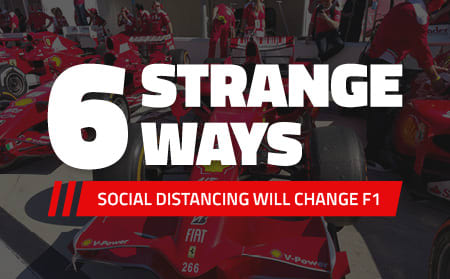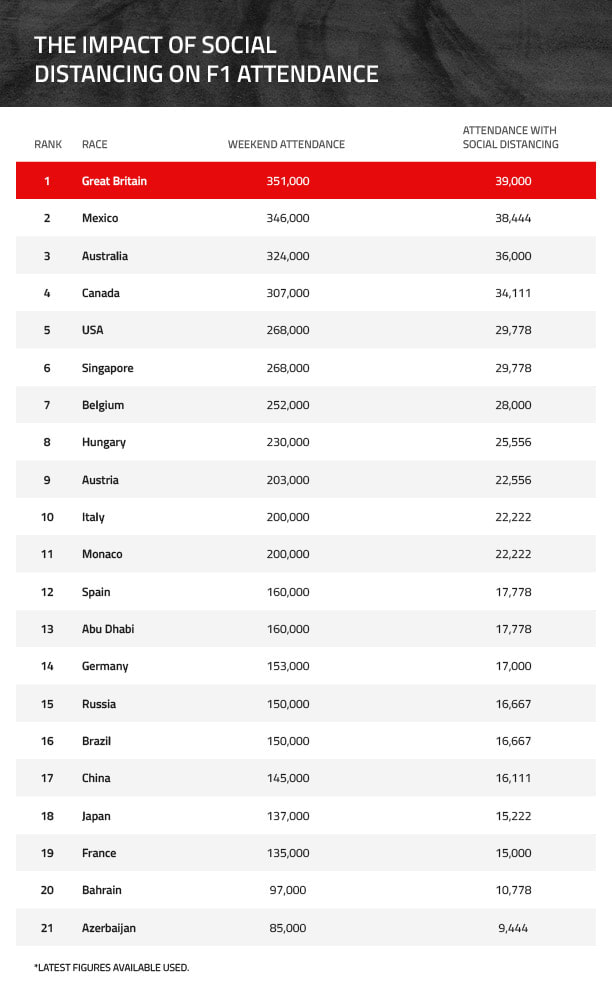From pit stops lasting longer to podium presentations taking place on the grid, the Coronavirus pandemic is set to impose severe restrictions on the upcoming F1 season and further into the future when crowds eventually return to the circuit.

On 19th June 2020, The World Motor Sport Council approved new coronavirus-related changes to F1s sporting regulations. Included in the new rules was guidelines in relation to how many members from each team are allowed on the track at the beginning of the race.
With F1 set to make its long-awaited return from suspension between Friday 3rd and Sunday 5th July 2020 due to the impact of the COVID19 pandemic, fans around the world are eagerly waiting in anticipation for the first Lights Out! in over 5 months.
Although fans wont be able to be present throughout the opening race weekends, Formula 1 CEO Chase Carey recently said that he is optimistic spectators will be able to attend races later in 2020. However, due to the pandemic and social distancing changes made by the World Motor Sport Council to keep participants safe, the sport will look a lot different once fans return.
Select Car Leasing has created a series of renders showing just how social distancing rules will impact Formula 1 once fans are allowed back into racetracks, along with how it will affect this weekends race at the Red Bull Ring. Simply use the slider functionality to swipe left and right to compare F1 before and after social distancing rules.
Pit Stops Will Take Longer
According to Andrew Green, Racing Points technical director, social distancing will mean that engine changes could take twice as long and because of this reliability will be key when F1 starts again. New procedures mean that the number of mechanics and engineers working on an F1 car at any one time has been reduced, and team members must also wear PPE. This could have a knock-on effect on pit stop times.
Green said We can only have certain members of the crew working on the car at any one time, and that does limit the speed in which you can do a power unit change. When we get into the real meat of the car, and centre around the power unit, were probably looking at, in some cases, it taking twice as long.
A way that F1 is seeking to protect those mechanics who need to break social distancing rules is imposing social bubbles between teams, meaning drivers and mechanics wont be able to mingle with their competitors and rivals throughout the race weekend.
Attendances Will Drastically Fall Even When Fans Return
Despite the first race of the F1 season taking place behind closed doors, Formula 1 CEO Chase Carey is optimistic spectators will be able to attend races later in 2020. Even when spectators do return to F1s famous grandstands, it will look eerily different to the packed pre-pandemic scenes we are used to seeing on TV such as the sea of orange when Dutchman Max Verstappen raced in Austria last year for Red Bull.
Social distancing will be in place throughout the circuit, meaning that at least the seats immediately surrounding a single fan will be vacated. This means for every 9 seats available, only 1 fan will occupy them. Select Car Leasing calculated how the weekend attendance figures for each circuit will be reduced should this system be put in place once fans return.
 Each racetracks attendance figures will be reduced by up to 89%, meaning that the Azerbaijan Grand Prix at Baku would receive under 10,000 fans. Great Britains grand prix, Silverstone, would be reduced from 351,000 spectators over a typical 3-day weekend to only 39,000.
Each racetracks attendance figures will be reduced by up to 89%, meaning that the Azerbaijan Grand Prix at Baku would receive under 10,000 fans. Great Britains grand prix, Silverstone, would be reduced from 351,000 spectators over a typical 3-day weekend to only 39,000.
Race Weekend Revenues Will Take A Hit

Due to the lack of spectators, F1 will also be impacted financially. It was reported in by ESPN in May that F1 has already been hit by a 84% drop in revenue due to the COVID19 pandemic while races were suspended, and this would continue even with some fans allowed into the racetrack. Presuming that there would be a ring of empty seats, or the equivalent distance, around every fan who attended a Grand Prix in a socially distanced was, race weekend revenues will take a hit.
The worst affected race will be the Gran Premio De Mexico, which before the pandemic generated around £100m per race weekend. Social distancing measures would greatly reduce this to only £11m, leaving a huge £89m hole in the circuits pocket.
Silverstone would be similarly impacted, only generating £10m for a weekend, down £83m from previous Grand Prixs.
Podium Presentations Could Take Place On The Grid
F1 is set to ditch traditional trophy ceremonies once the season begins again, although other options are being mooted. F1s sporting director, Ross Brawn, recently said Because of the implementation of the procedures, we need to be safe and sure of the Covid-19 situation. The practices we have had in the past just cant be done. The podium procedure cant happen, but were looking at doing something on the grid after the race. One option would be to line the cars up on the track and the drivers will stand in front of cars.
Even with podium presentations taking place on an empty track, there will be no celebratory champagne being sprayed that has become commonplace at the end of each grand prix, not to mention Daniel Riccardos famous shoey.
The Starting Grid Will Be Deserted
Starting at the Red Bull Ring next weekend, the race-start procedure will now commence with the pitlane opening 30 minutes before the start of the race, 10 minutes later than usual. Once the pit exit is opened, only a maximum of 40 personnel from each team will be allowed on the grid in order to comply with social distancing rules. Gone are the days of Martin Brundle fighting through a packed crowd during his grid walks to speak to celebrities and personnel from each of the F1 teams.
Fans Areas Will Have Strict Social Distancing Rules
In times gone by, many fans stayed away from the grandstands in favour of sitting on the hilly areas surrounding most racetracks on the F1 circuit. This allows spectators to freely move around the track during the rave rather than always having to sit in one place. Once fans return to racetracks, they will need to be separated by at least 1m or 2m depending on the social distancing rules in place, depending on the country the race is being held in. The imagery above shows what a packed curve at the Circuit de Catalunya in Barcelona will look like before and after social distancing rules are introduced.















